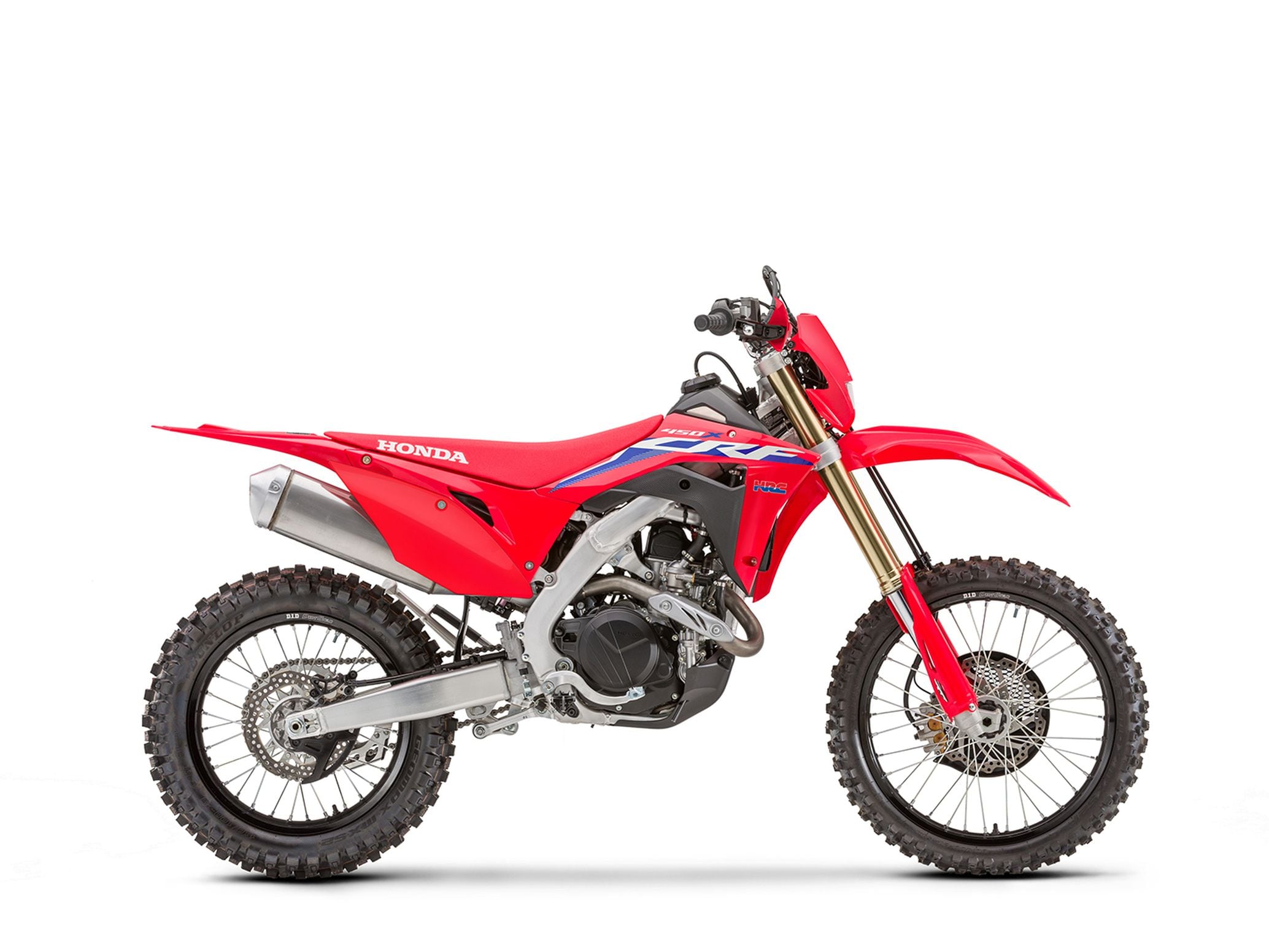2021 Honda CRF Performance Lineup Model Information
Details on Big Red’s all-new CRF450R, CRF450RWE, and CRF450RX.

We first saw Team Honda HRC’s Tim Gajser’s and teammate Mitch Evans’ Honda CRF450RW machines back in late January 2020 when the Japanese manufacturer released photos of the bikes that would be piloted by its two MXGP class-contending riders in the FIM MXGP World Championship. The CRF450RW is a works bike developed by Team HRC’s engineers and the technical staff of Honda Racing Corporation and Honda’s R&D department in Japan, but it gave us an idea of what we might see on Big Red’s 2021 flagship motocross bike being that the CRF450R was at the end of its four-year production cycle in MY20.
Related: 2021 Honda CRF450R, CRF450RWE, And CRF450RX First Look

Sure enough, the 2021 Honda CRF450R is all-new and shares some of the basic design features seen on Gajser’s and Evans’ works bikes including a new frame, swingarm, hydraulic clutch, bodywork, and more. The CRF450RWE (Works Edition) and CRF450RX cross-country machine enjoy the same updates as the CRF450R as well. The CRF450X trailbike and the renamed CRF450RL dual sport both feature new graphics and hand guards.

The remainder of the CRF Performance lineup, comprised of the CRF250R, CRF250RX, CRF150R, and CRF150R Big Wheel, remain unchanged for 2021. Also, Honda will be doing an additional production run of the 2020 CRF450R and offer it at a permanent price reduction. With it retailing for $8,599, Honda’s intention of continuing to offer its MY20 flagship motocrosser is to provide a motocross bike for customers seeking high performance with a lower price tag.
ADVERTISEMENT / ADVERTISE WITH US
The 2021 Honda CRF450R was designed around the development theme of “razor-sharp cornering” with the platform goals being improved power with a focus on corner exit, improved consistency for both the bike and rider, and improved handling. Beginning with the engine, Big Red made the exhaust port more centrally located and oval-shaped, a change from the previous generation’s round shape. The intended benefit of these changes is to improve exhaust efficiency and increase power from the midrange to top-end (5,000 rpm and up).

The camshaft has been redesigned with a new decompression system. Valve lift and timing have also been reconfigured to increase power. The decompression system’s counterweight has been relocated from the right side of the camshaft to the left; it is now located on the cam sprocket, which is bolted onto the camshaft as opposed to being pressed on like it was on the prior model. According to Honda, this improves combustion stability in the extremely low rpm range and contributes to a strong but manageable power delivery in corner exits as well as resistance to stalling. The magnesium valve cover also uses a thinner material for weight savings.

The airbox, airboot, and air filter on the 2021 CRF450R are completely different from the prior generation model. The MY21 bike’s airboot has been enlarged to 4.1 liters (compared to 1.8 liters on the 2017–2020 model), which is said to result in better torque at low rpm. As for the air filter itself, it is a different size and shape, the rubber ring has been eliminated to simplify cleaning, and an external frame has been added to ensure a good seal is maintained. The airbox is now accessed with the removal of a single side panel bolt.
ADVERTISEMENT / ADVERTISE WITH US
In an effort to improve intake efficiency and torque feel, the angle of the fuel injector has been increased from 30 degrees to 60 degrees. According to Honda, this enables the spray to reach all the way to the back of the butterfly valve, thus cooling the upstream side of the intake path. The new, smaller fuel pump is claimed to be 120 grams (0.26 pound) lighter than the outgoing unit and the number of bolts used to affix it has been reduced from six to four. Fuel pressure and filter life are both said to be unaffected despite these changes.

For the first time since 2012, the CRF450R features a single muffler exhaust system, which is said to improve bottom-end torque delivery. According to Honda, the entire exhaust system now weighs 8.5 pounds, which is a reduction of 2.7 pounds from the previous unit. Another notable change to the exhaust system is the header pipe, which is now routed 74mm (2.9 inches) closer to the engine on the right side; this was achievable due to the engine’s new centralized exhaust port location. Also, the heat shield on the header pipe has been eliminated to reduce weight.
The muffler has been reshaped to move its outer surface 13mm (0.5 inch) inward. The combined result is a slimmer overall body profile, which is intended to contribute to freedom of movement for the rider. The exhaust system features two resonators that are designed to boost power and reduce noise.
ADVERTISEMENT / ADVERTISE WITH US
The clutch is one of the biggest updates the CRF450R receives for MY21. It is now hydraulically actuated, boasts a 27 percent larger capacity, features an additional friction plate (for a total of eight), an extra steel plate (for a total of seven), and stiffer springs. The combination of these changes are designed to provide a lighter lever pull, reduced slip, and more consistent performance. Honda also added a friction spring to the clutch to suppress resonance and improve power delivery.

As far as electronics, the 2021 CRF450R utilizes an all-new handlebar-mounted switch to allow the rider to toggle between three ignition maps (standard, smooth, and aggressive), three levels of Honda Selectable Torque Control (HSTC), and three modes of HRC Launch Control. It’s worth noting that HSTC can be turned off completely as well.

The chassis is another significantly updated part of the all-new CRF450R. The geometry of the bike has been changed in an effort to improve cornering. Honda shortened the wheelbase by 1mm, relaxed the rake by 0.5 degree, reduced the trail by 2mm, steepened the swingarm angle by 0.9 degree, increased the seat height by 5mm, increased the ground clearance by 8mm, and lengthened the distance from the front axle to the swingarm pivot by 1.8mm.
ADVERTISEMENT / ADVERTISE WITH US
The frame is all-new with narrower main spars, a redesigned downtube, and rearranged reinforcement ribbing on the backside of the pivot plate. According to Honda, these changes contribute to an overall weight reduction of 1.5 pounds. With that, the new frame weighs a claimed 18.5 pounds. Lateral rigidity has been reduced by 20 percent, while vertical rigidity is maintained.
Through a simplified subframe design, Honda was able to get rid of a separate seat support that was mounted on it. According to Big Red, the new subframe weighs 2.0 pounds, which is just over 0.7 pound less than the component on the prior generation bike. Additionally, the swingarm is narrower with rebalanced rigidity tuned to match the frame, which is designed to improve rear wheel traction and cornering.

Like the 2017–2020 models, the new generation CRF450R is spec’d with a Showa 49mm coil-spring fork, but it differs in a couple of ways. Its stroke has been increased by 5mm to better absorb rough terrain and reduce pitching, and the axle holders have an updated design for increased rigidity. The upper and lower triple clamps have both been redesigned as well, with the rigidity being rebalanced via updated reinforcement ribs. The changes made to the triple clamps are said to deliver increased flex characteristics for improved handling and feel through corners.
The Showa shock has been adapted to work with the new frame including its adjusters having been moved from the left side to the right. A switch to an ultra-light steel shock spring was made for further weight savings. The link ratio and rear travel have also been changed so that acceleration-triggered rear end squat is reduced.

With the elimination of the left-side muffler, the left side panel is positioned 50mm inward. With the new muffler shape, the right side panel was able to be moved inward by 20mm as well. These revisions result in a 70mm reduction in width at the rear of the bike. The junction of the radiator shroud and the side panel is said to be smoother too. All of these changes are intended to facilitate easier rider movement.

The new radiator shrouds are produced in a single piece instead of two separate parts. Computational Fluid Dynamics (CFD) were used to design new air outlet vents in the shrouds. The radiator louvers have also been revised to optimize the number of fins and their angle, resulting in a claimed 5 percent improvement in cooling performance. The radiator shroud width has not been changed.

The seat base and the way it is mounted have also been redesigned. Whereas it was previously installed by sliding it forward onto the subframe and then securing it at the rear, the new seat base has front-located mounting tabs and rearward-facing tongues. These changes were made to ease installation and enable acceleration forces to help keep the seat in place. The 1.7-gallon titanium fuel tank has a new design and its plastic cover has been eliminated. While the 2017–2020 CRF450R came with Dunlop MX3S tires, the 2021 machine’s wheels are shod with Dunlop’s newest soft to intermediate motocross tire, the MX33.

Honda took some additional smaller measures to reduce the overall weight of its flagship motocross bike. One of which is the use of eight bolts—four less than the previous model—to fasten its new main bodywork components including both radiator shrouds, both side panels, and the seat. Additionally, all of the bolts for the main bodywork parts have 8mm heads so that only one tool is needed to remove them. A further 98 grams (0.2 pound) were cut by combining what used to be two left-side handlebar switch assemblies into a single cluster that addresses functions including the engine stop, ride modes, and Honda Selectable Torque Control (HSTC). According to Honda, routing the throttle and clutch control cables behind the handlebar instead of in front made for a weight reduction of 100 grams (0.2 pound) as well.

According to Honda, it shaved 3 pounds off the overall weight of the all-new 2021 CRF450R, giving the bike a claimed wet weight of 244 pounds. Big Red’s flagship motocrosser will be available in September 2020 for $9,599.

In addition to the CRF450RWE enjoying all of the same changes as the standard model CRF450R, the MY21 version of Honda’s special edition motocross bike features a unique cylinder head with factory, hand-polished ports, a Yoshimura RS-12 full titanium exhaust system, titanium nitride-coated lower fork legs, D.I.D DirtStar LT-X rims, a Hinson Racing clutch basket and cover, Twin Air air filter, red valve cover, and Team Honda HRC graphics by Throttle Jockey.

The CRF450RX maintains its place in the CRF Performance lineup as Honda’s flagship cross-country model. For 2021, the off-road-focused machine gets the same performance upgrades as the motocross-focused CRF450R and retains off-road-specific features like dedicated ECU and suspension settings, a larger fuel tank, an 18-inch rear wheel, and an aluminum sidestand. New for 2021, the CRF450RX comes standard with hand guards and a revised 2.1-gallon fuel tank that is claimed to narrow the width at the radiator shrouds by 17.7mm (0.7 inch).




